Let's Talk Resilient: VCT Tips from the Pros

The largest selling resilient flooring product in terms of square footage is Vinyl Composition Tile or VCT. It's inexpensive to buy and easy to install but like any other flooring product there are ways to do it well and ways to cut corners so the installation will not be as good as it could be. I see a lot of VCT installations in my travels, from schools to supermarkets to big department stores. I am amazed how sometimes I see a job that looks great - with nice tight seams and a smooth surface, and other times I see floors with gaps, cracks and bumps and I know that the installer was probably under the gun and had to get the job done quickly without proper preparation or testing. Here are some hints for a successful VCT installation, and some feedback from two of the most knowledgeable "tile guys" in North America.
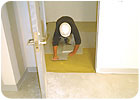
First of all, let's clarify some terminology. You probably are hearing the terms Vinyl Tile, Premium VCT, Luxury Vinyl Tile (LVT), Solid Vinyl Tile (SVT), and Vinyl Enhanced Tile (VET). What's the difference between these products and how do they compare to Standard VCT? The answer is in the ASTM standards, and there are two for vinyl tile; ASTM F 1066 for Vinyl Composition Floor Tile (VCT) and ASTM F 1700 for Solid Vinyl Floor Tile (SVT). Premium VCT is almost the same or exactly the same as standard VCT but may have more authentic patterns such as granite looks or may be available in solid colors. These products cost more to make so they are at a "premium" price point. As far as VET and other "higher vinyl content" VCT products, all of these are classified as VCT. The higher vinyl content often allows for larger sizes, improved visuals, easier maintenance and better indentation resistance, and may mean different adhesives and installation time than VCT.
Solid Vinyl, or SVT has higher vinyl content than VCT and is another category altogether. The term "Luxury Vinyl" has created unnecessary confusion in the industry. The fact is, there is not an industry standard for LVT. Some solid vinyl tile products that imitate wood, stone and other materials are often called LVT. However, there are also products marketed as LVT that are residential grade and are actually VCT because they don't have enough vinyl content to be called SVT. So, "Luxury Vinyl" can be SVT or VCT. The manufacturers would do the industry a favor by clarifying this difference in their marketing and sampling. I've covered solid vinyl in past columns, so for now we'll talk about the entire VCT category.

For starters, job site conditions are, as with all resilient products, a key to success. It's no secret that many large VCT installations are going in today in buildings without a climate control system, or over concrete that is not yet fully dried. VCT is pretty forgiving, but I still do not recommend doing jobs in these cases. If you install a school job or another commercial job in the summer with no air conditioning, it's not unusual for the tile to "grow" a little because of the heat. If you install it in that condition, when the tile cools down later on, some gaps may develop as the tile returns to its original size. Ideal conditions are around 70 degrees (plus or minus 10 degrees or so), and the manufacturers have published guidelines that say that. If you are being asked to install in conditions that are otherwise, cover yourself by letting someone know that the manufacturer's guidelines are not being followed. Another tip is to get the material on to the job site at least two days before installing, and store it in conditions as close to that 70 degree mark as you can. This will help the product stabilize. If the area is exposed to direct sunlight, keep the flooring out of the sunlight by covering the windows while the product is acclimating, during installation, and after installation until the adhesive is cured.
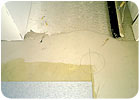
Another issue, as we discussed in my last column, is moisture testing. It is often assumed that VCT is more moisture tolerant than other flooring materials, but moisture related failures can and do happen on VCT just like any other flooring material. If you haven't seen my past articles about the causes of moisture related failures and ways to test for it, I recommend you go to my website at www.FlooringAnswers.com and do some reading. Moisture and pH problems are still the number one cause of flooring failures, and VCT is no different, so testing is important.
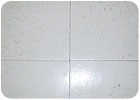
As far as surface preparation, it is the same as with other resilient flooring products. Follow the guidelines in ASTM F 710, which states that existing concrete substrates must be "be free of dust, solvent, paint, wax, oil, grease, residual adhesive, adhesive removers, curing, sealing, hardening, or parting compounds, alkaline salts, excessive carbonation or laitence, mold, mildew, and other foreign materials that might prevent adhesive bond."
To make sure the floor is smooth ASTM F 710 says, "Surface cracks, grooves, depressions, control joints or other non-moving joints, and other irregularities shall be filled or smoothed with latex patching or underlayment compound recommended by the resilient flooring manufacturer for filling or smoothing, or both. Patching or underlayment compound shall be moisture-, mildew-, and alkali-resistant, and, for commercial installations, shall provide a minimum of 3000 psi compressive strength." Check with the VCT manufacturer to see if they have specific product recommendations for floor preparation. Above all, make sure the substrate is very smooth before you start laying the floor. Any dips or low spots in the floor can be a cause of bubbling or cracking after installation, as can installing over expansion joints or trench cuts in the floor where the concrete is not yet dry.

I asked John Kozak, Installation & Technical Service Manager for Tarkett commercial what problems he encounters with failed VCT installation. "The #1 problem is still not checking for moisture," he said, "and next comes subfloor preparation and correction, though I think they should both be linked together as the same error. In other words, the finished product will only look as good as the substrate it is installed upon. I have seen too many floors that look great right after installation, but end up looking like a moonscape after 10 coats of a super high gloss finish are applied."
Another area of concern in regard to floor preparation is removing old tile and dealing with the adhesive residue. In his July, 2000 article for FCI, Ray Thompson talked about one of the challenges in renovation projects, which is what to do about old black cutback adhesive. "It depends on the circumstance. A cutback adhesive that is active (not scaly or poorly bonded) can be scraped down to a thin residue, and a clear thin-spread can be applied directly over the residue. Do not apply a cutback adhesive over a cutback adhesive, as they tend to create excess and will bleed." Ray makes a good point about bleed through, which can happen when there is a concrete moisture problem, when excess adhesive is applied because of too large a trowel notch, or when new adhesive is applied over old adhesive. Although many adhesives available today say "can be used over old cutback", if you do this it needs to be done right. I tend to be pretty conservative with my recommendations in this regard and I have a simple rule. If it's black adhesive, scrape it down to a thin transparent residue and then "skim coat" with a good quality cement based patching compound that is made for going over cutback residue. If it's not black, it must be completely removed from the floor. Whatever you do, don't just remove the old tile and skim coat over what's there, or apply adhesive over what's there.
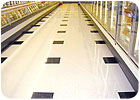
When removing old tile or adhesive, remember that older floors or adhesive may contain asbestos. I remember well the late 1970s when asbestos was banned as an ingredient in resilient flooring, but I can't seem to get an answer to the question of exactly when sales of asbestos containing flooring stopped. How can you tell if a floor is asbestos? Some assume that all 9-by-9-inch tile contained asbestos and that 12-by-12-inch tile did not. This is not true, because there was a lot of 12-by-12 Vinyl Asbestos Tile! To be safe, assume that any sheet vinyl or vinyl tile floor installed before 1990 may contain asbestos so before you remove it make sure somebody has it tested, and remember some old cutback adhesives contain asbestos too.
Once the issues of testing and preparation are addressed, spreading the adhesive is next. One thing a lot of installers tell me they like about VCT installation is that large areas of adhesive can be spread at one time and there is a very long working time so you don't have the "stop and start" that you do with wet lay adhesives. However, some of the vinyl enhanced, premium or other high-end VCT products are installed more like SVT and use a variation on the wet lay method of installation. Check the installation specs, because these products usually don't get installed with standard VCT adhesive so there may be a higher cost for adhesive and more time needed for installation.
Depending on the job, you have several choices in adhesive for VCT with regard to open time and working time. Open time is how long the adhesive stays open to the air after you spread it and working time is how long you have to cover it once the open time has expired. Some VCT adhesives, such as acrylics and epoxies, have short open times and working times, and are a "wet lay" installation. Other "thin spread" adhesives have open times of 30-60 minutes and working times of 6 to 24 hours. Make sure you match the adhesive you are using to the type of installation you are on. Even with adhesives designed to have a long working time, I prefer not to leave adhesive over night because it will attract dust, dirt, and worse when nobody is there to keep an eye on it. Pay attention to trowel notch size as well when you are looking at adhesive selection for VCT. Some adhesives are designed to go down with a fine notch (1/32-inch) and others a larger notch (1/16-inch). More is not better! Too much adhesive can cause bleed through, tile shifting, cracking, or indentations. Another point that gets missed is rolling the floor. Some adhesives require it and some do not. Don't forget to roll the floor if the instructions call for it because failure to do so can mean a very weak bond to the substrate.
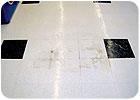
Once you get into laying the tile, "run off" is a big problem for a lot of installers. Ray Thompson listed three causes of this. First is the flatness of the substrate. "The more undulation there is in the surface of the floor, the more the tendency for the tile to run." Another cause, Ray said, is the way the installer sets the tile into the adhesive "The installer needs to be aware of the tile joints during the installation by keeping the opposing corners aligned. Installers may pull the tile during the installation because they hold it by the corner, twisting and moving it out of alignment. The tendency is for a right-handed installer, holding the tile by the right corner, to pull the right side of the tile in tighter than the left side. A tile needs to be held in the center." Finally, tile run off often gets blamed, incorrectly, on the tile being "out of square", but, Ray says "It has been my experience that tile is rarely out of square, but often gets the blame for the above two reasons."
John Kozak also had some feedback on this subject, saying "As in all things, correcting the situation before it gets out of hand is important. Make sure while installing to follow your accurately placed layout lines. It is more important to be sure the lines are followed rather than letting the tile guide you while installing." What about "correcting" the tile if it starts to run off? "Small corrections while working can keep run off under control," Kozak said, "Making an occasional cut-back or leaving out a tile and doing a sweat-in when needed also helps." By "cut back," John means stopping and cutting the tile a small amount to create a straight line again. A "sweat-in" means to skip a tile or tiles, start a new straight row, and then heat up tiles to fit into the slightly smaller space that is left.
Some of these practices add time to the job, but like all of the other details we have mentioned here, a little extra time spent can make the difference and give the owner a good looking finished product that is flat and tight.
Looking for a reprint of this article?
From high-res PDFs to custom plaques, order your copy today!



